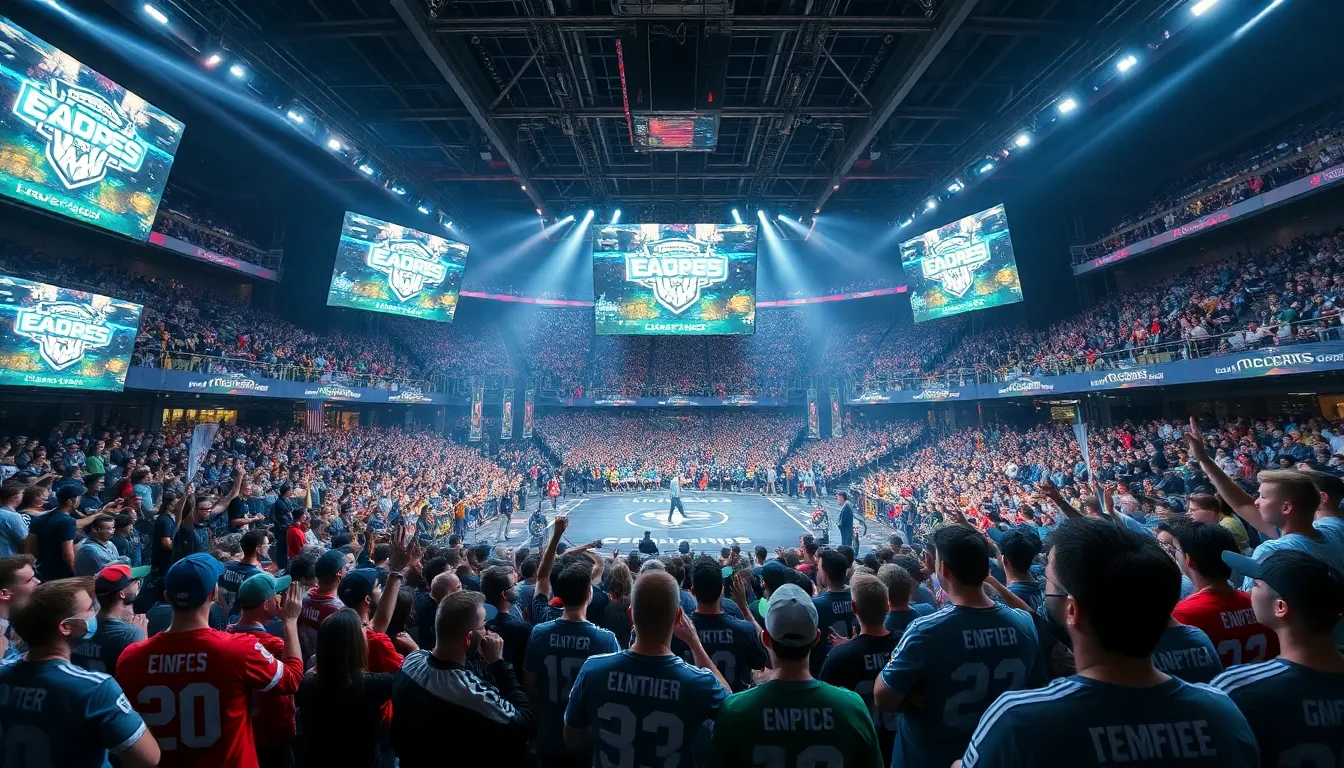Esports has rapidly evolved from a niche pastime into a global phenomenon, captivating millions of fans and players alike. As the competitive gaming landscape expands, so does the potential for monetization, making it a hot topic among industry insiders. Understanding how to effectively capitalize on this booming sector is crucial for teams, sponsors, and game developers.
From sponsorship deals and merchandise sales to streaming revenue and in-game purchases, the avenues for generating income are diverse and constantly changing. As esports continues to gain traction, exploring these monetization strategies not only highlights the industry’s growth but also reveals the innovative ways stakeholders can engage with audiences.
Table of Contents
ToggleUnderstanding Esports Monetization
Esports monetization refers to the various strategies employed within the competitive gaming industry to generate revenue. Understanding these methods is essential for stakeholders aiming to capitalize on the industry’s growth.
Definition and Importance
Esports monetization encompasses revenue generation strategies relevant to tournaments, organizations, and content creators. These strategies are vital for sustaining operations, fostering growth, and enhancing fan engagement. As audiences continue to expand, effectively monetizing esports becomes increasingly critical for ensuring profitability and attracting investment.
Key Components of Monetization
- Sponsorship Deals
Sponsorship deals provide financial support to teams and events, offering brands visibility through logos and advertisements.
- Merchandise Sales
Merchandise sales encompass branded apparel and accessories, catering to fan loyalty and enhancing team identity.
- Streaming Revenue
Streaming revenue arises from platforms like Twitch and YouTube, allowing content creators to earn through subscriptions, donations, and ad revenue.
- In-Game Purchases
In-game purchases include items, skins, or currency, generating revenue through player engagement and enhancing the gaming experience.
- Event Ticket Sales
Event ticket sales contribute to revenue for live competitions, allowing fans to attend in-person events, creating memorable experiences.
- Media Rights
Media rights sales involve selling broadcasting rights to networks, allowing they to air tournaments and generate viewership, leading to additional advertising revenue.
- Affiliate Marketing
Affiliate marketing involves partnerships where businesses earn a commission for promoting products or services within the esports community.
- Crowdfunding
Crowdfunding enables fans to support teams and events, increasing financial support while fostering community engagement.
Exploring these key components highlights the diverse avenues through which stakeholders can monetize esports effectively.
Revenue Streams in Esports

Multiple revenue streams drive the growth and sustainability of the esports industry. Understanding these streams helps stakeholders capitalize on this expanding market.
Sponsorships and Advertisements
Sponsorships and advertisements represent significant income sources for esports organizations. Companies partner with teams and tournaments to promote products and services to a vast audience. Sponsorship deals can range from $5,000 to several million dollars, depending on the team’s popularity and tournament size. Brands leverage in-game advertising, displaying their logos on team uniforms, streaming overlays, and event banners. Such partnerships offer companies increased brand visibility and engagement with a dedicated fan base.
Merchandise Sales
Merchandise sales provide another vital revenue avenue for esports teams and players. Items such as apparel, accessories, and collectibles help fans express their support. Estimated merchandise sales can generate from $50,000 up to millions annually for popular teams. Online stores, live events, and collaborative products with renowned brands amplify sales opportunities. Effective marketing strategies, such as limited-edition releases and special promotions, further enhance profitability.
Ticket Sales and Events
Ticket sales for esports events continue to grow as tournaments attract large audiences. Major competitions may fill arenas with thousands of fans, generating significant revenue through ticket sales. Prices can range from $20 to over $200 per ticket, influenced by factors like location, team popularity, and seat selection. Live events also contribute additional income through merchandise sales, food and beverage sales, and exclusive experiences. The expansion of live tournaments strengthens fan engagement and drives overall revenue in the esports ecosystem.
Streaming and Content Creation
Streaming and content creation play vital roles in the monetization of esports. These platforms offer extensive opportunities for creators to engage audiences while generating revenue.
Platforms for Streaming
Numerous platforms facilitate esports streaming, including Twitch, YouTube, and Facebook Gaming. Twitch remains the leader, boasting over 140 million monthly users. Creators monetize through subscriptions, donations, and advertising revenues. YouTube offers additional monetization options, such as ad revenue sharing and sponsorships, allowing creators to diversify income through video content. Facebook Gaming provides integration for social sharing, enabling creators to tap into a vast audience base. Each platform’s unique features enhance a creator’s ability to connect with viewers and capitalize on their content, making streaming an effective monetization strategy.
Influencer Marketing and Brand Partnerships
Influencer marketing drives significant revenue in esports. Content creators often collaborate with brands to promote products or services. Successful partnerships result in sponsored streams and promotional content, heightening brand visibility. For instance, gaming peripheral companies frequently engage streamers to showcase their products during broadcasts. These collaborations provide value for both parties: influencers receive financial compensation and brands gain access to engaged audiences. Additionally, esports teams often leverage their players’ influence to secure lucrative sponsorship deals, forging connections with brands that align with their values and target demographics. This approach strengthens brand loyalty, amplifying revenue potential for both teams and influencers.
In-Game Purchases and Microtransactions
In-game purchases and microtransactions constitute a significant revenue stream in esports, allowing players to buy virtual goods that enhance their gaming experience. Game developers leverage these transactions to monetize their titles beyond initial sales.
Types of In-Game Purchases
- Cosmetic Items
Cosmetic items, such as skins, outfits, and emotes, allow players to customize their avatars without affecting gameplay. Popular titles like League of Legends and Fortnite attract significant sales through vibrant visual upgrades.
- Battle Passes
Battle passes offer a tiered system for unlocking rewards within a set time frame. Players engage in challenges to earn exclusive content, as seen in Call of Duty: Warzone and Apex Legends.
- In-Game Currency
Many games implement virtual currencies allowing players to purchase items, upgrades, or unlock features. Titles like FIFA and NBA 2K often sell in-game currency, driving recurring purchases for gamers.
- Expansion Packs
Expansion packs introduce new content, such as maps, characters, or storylines, expanding the game’s universe. Games like World of Warcraft exemplify the success of expansion packs in player engagement and financial gains.
- Loot Boxes
Loot boxes offer randomized rewards, enticing players with the chance of obtaining rare items. While controversial, loot boxes in games like Overwatch generate substantial revenue through player investment.
Impact on Revenue Generation
In-game purchases significantly bolster revenue generation in the esports ecosystem. Reports indicate that microtransactions can account for over 70% of a game’s total earnings, especially for free-to-play titles. Companies benefit from a continuous influx of funds as players are motivated to invest in enhancing their gaming experience. This model fosters sustainable revenue, enabling developers to maintain and grow their games through updates and expansions, ensuring ongoing player engagement and satisfaction.
Challenges in Esports Monetization
Esports faces several challenges in monetization that stakeholders must navigate to achieve sustainable revenue streams. These challenges include market saturation and regulatory compliance issues.
Market Saturation
Market saturation limits growth opportunities for esports monetization. With numerous teams, leagues, and tournaments competing for the same audience, differentiating brands becomes increasingly challenging. Increased competition leads to fragmented fan engagement, making it difficult for advertisers to identify which platforms offer the best return on investment. Additionally, viewer fatigue can arise from an overwhelming number of events and content, resulting in diminished audience interest. Brands seeking partnerships may hesitate to invest heavily when faced with multiple options and uncertain outcomes. Thus, organizations must adopt innovative strategies to stand out, including unique content offerings, targeted advertising, and personalized fan experiences.
Regulation and Compliance Issues
Regulation and compliance issues present significant obstacles in esports monetization. Laws regarding gambling, advertising, and data privacy can vary greatly by region, complicating how organizations engage with fans and monetize their activities. For instance, many esports events incorporate betting elements, which require strict adherence to legal frameworks in different jurisdictions. Failure to comply with these regulations can lead to severe penalties, including fines and reputational damage. Furthermore, sponsorships and partnerships with brands must consider advertising restrictions, especially when targeting younger audiences. Consequently, esports entities must maintain a thorough understanding of regulatory environments to ensure compliance while maximizing monetization opportunities.
The esports industry is rapidly transforming into a lucrative marketplace. As it continues to grow millions of fans and players are drawn into its vibrant ecosystem. Stakeholders who embrace diverse monetization strategies are better positioned to thrive in this competitive landscape.
From sponsorships to in-game purchases the potential for revenue generation is immense. Adapting to industry challenges will be crucial for sustained success. By leveraging innovative approaches and understanding audience dynamics esports organizations can unlock new revenue streams and foster deeper connections with fans.
The future of esports monetization looks promising and with the right strategies in place it’s set to redefine the gaming experience for players and audiences alike.





